Dick Mol and Wilrie van Logchem (The Netherlands)
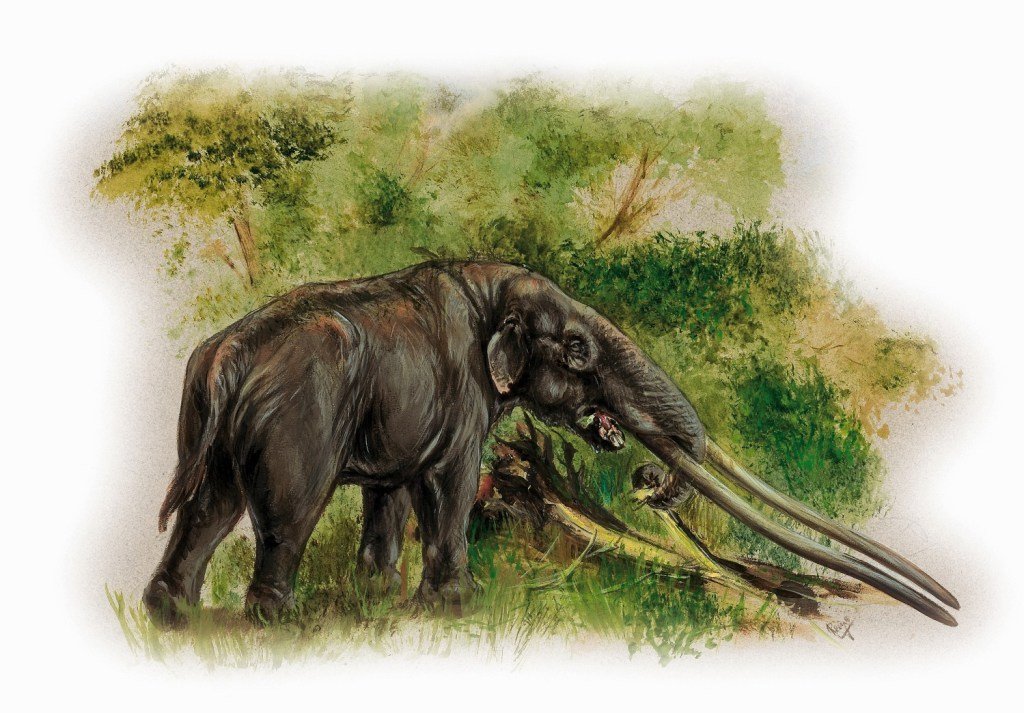
Elements of a skeleton of a Pliocene mastodon have been excavated close to the village of Milia in West Macedonia, Greece, between 17 and 29 July 2007. Members of the Aristotle College in Thessaloniki, along with the authors, unearthed the specimens in a sandpit, named “Milia 5” (as there had been already 4 earlier excavations websites of fossil mammals within the neighbouring space). The circumstances below which the occasion befell have been relatively excessive. Whereas in north-west Europe, the climate resembled an autumn day in October, in Milia, the excavators needed to work in temperatures of greater than 40oC.
On this article, we are going to give a brief report in regards to the excavation, along with some details about this mastodon (Mammut borsoni).
Throughout digging work in October 2006, a crane operator found a fossil tusk in a sandpit in Milia. He contacted Professor Evangelia Tsoukala of the Aristotle College. She is a palaeontologist, specialising in mammals and had already accomplished 4 excavation tasks for Pliocene mammals within the Milia area, all of which have been fairly superb. One in every of these had resulted to find the earlier longest pair of tusks on the planet.

These belonged to a mastodon, with the scientific identify of Mammut borsoni, and measured 4.39m every.
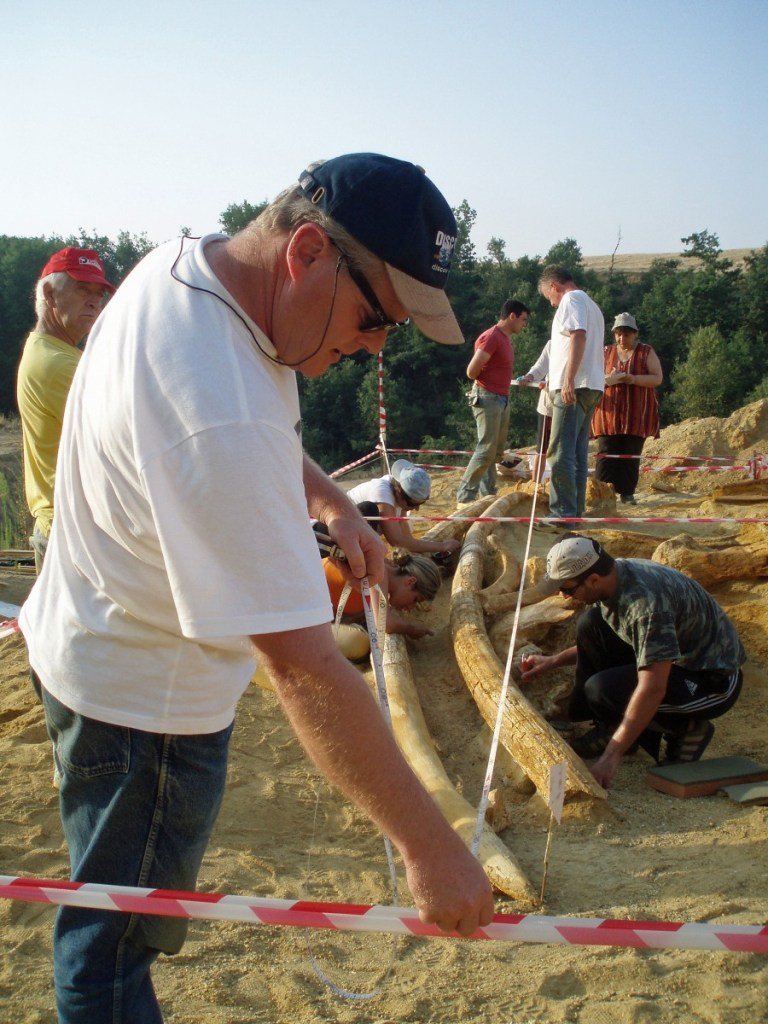
The tusks are nearly straight, hardly curved in any respect and, in a dwell mastodon, would have caught out horizontally proper in entrance. This Proboscidean differed from different species, like fashionable elephants, having a distinct physique form. It was far more elongated, whereas its enamel and metabolism have been optimized for looking twigs and leaves.
| Borson’s mastodon |
|---|
| Mammut borsoni (also called Borson’s mastodon) was described by the American anatomist, Isaac Hays, in 1834. His description was based mostly on the cast of an upper right molar discovered in the vicinity of Villanova d’Asti in northern Italy. The original specimen is in the collection of the Museo di Geologia e Palaeontologia della Università di Torino, Italy, under catalogue number PU 14896. The director of that museum at that time, Abbé Etienne Borson, included this right last molar (M3 dext.) in his catalogue in 1830 and named it “Dent qui appartient au grand Mastodonte” (page 706). Borson had sent the cast to Isaac Hays, who recognised it as quite similar to the molars of the American mastodon (Mammut americanum) described by Kerr in 1792. However, he was convinced about apparent differences. Therefore, he decided to describe the molar from Villanova d’Asti (with a geological age of Late Pliocene) as a new species. Honouring Mr Borson, he named this species, Mastodon borsoni. Nowadays, this species is put into the genus Mammut and, therefore, the current, correct name is Mammut borsoni. Both Mammut borsoni and Mammut americanum are put in the family of the Mammutidae, subfamily Mammutinae, being zygodont mastodons, with molars showing typical, comb-shaped ridges. M. borsoni was a massive sturdy pachyderm, with male bulls reaching shoulder heights of almost 4m and some developed gigantic tusks. It is also the largest known mastodon. Borson’s mastodon, which is found both in Europe and Asia, became extinct towards the end of the Pliocene about 2.5 to 3 million years ago, whereas the American mastodon survived, at least until the early Holocene, some 10,000 years ago. |

We were very lucky to be in Greece participating at the 12th International Cave Bear Symposium and studying the collections of Evangelia Tsoukala when this new discovery was made. This opportunity fell right into our hands. Bothtusks, still in situ, were still being excavated and a measuring tape revealed that one was at least 5m in length. That certainly required more research. Evangelia Tsoukala included us in a plan for excavation to take place in July 2007, since there might be a lot more to be uncovered. The contractor agreed, albeit reluctantly, to postpone the digging activities in that part of the sand pit.

We were invited to participate in the excavation starting on 17 July 2007. Vigorous discussion took place about which part should be the first to be uncovered and how generally to proceed. The highly motivated excavation team of about 12 students was led by the principal investigator, obviously professor Evangelia Tsoukala, in close coordination with the co-principal investigator, Dick Mol.

To reach the layers quickly where the fossil remains were embedded about 2.5 million years ago, we used a large excavator to remove sand overburden. The next day, the first tusk was completely exposed and the second was localised, and found to be slightly shorter. Unfortunately, the state of preservation was not very good and, therefore, recovery would be very delicate. Meanwhile, it turned out that the excavation area of 8m by 4m, nicely marked out with red-white marker tape, contained a lot more remains of the original owner of these giant tusks. And a part of the skeleton was recovered in the next few days under a scorching hot sun, with temperatures of up to 45oC.

Apart from the giant tusks, parts of the upper jaw bone (with a splendid molar) were uncovered, followed by the lower jaw with molars somewhat later. Although broken, it was in excellent condition. This mandible had lost the lower tusks, but the tusk-sockets were well preserved. Mammut borsoni had rather large lower tusks with a diameter of 6cm to 8cm at the symphysis of the mandible. The last and penultimate molars are present, revealing not only that this mastodon must have been a browser, but also something about its age when it died. From these particular fossil remains, we concluded that its age must have been between 25 to 30 years at time of death. The huge limbs reveal the enormous dimensions of this bull in his prime. These discoveries are unique and very spectacular.
The excavation activities were watched by the locals of the little village of Milia, who provided the team members with nice, cool, clean water and ice cream on a regular basis. Also, two local TV stations appeared on the set, taking some shots and, when these were shown that night, the BBC was alerted. Next day, its journalists called Evangelia Tsoukala asking what was going on. She asked Dick Mol to do the talking and to reveal the initial results of the activities. Nowadays, the interest of the media is considered very important, since it may provide a sound public appreciation of such expensive scientific research.
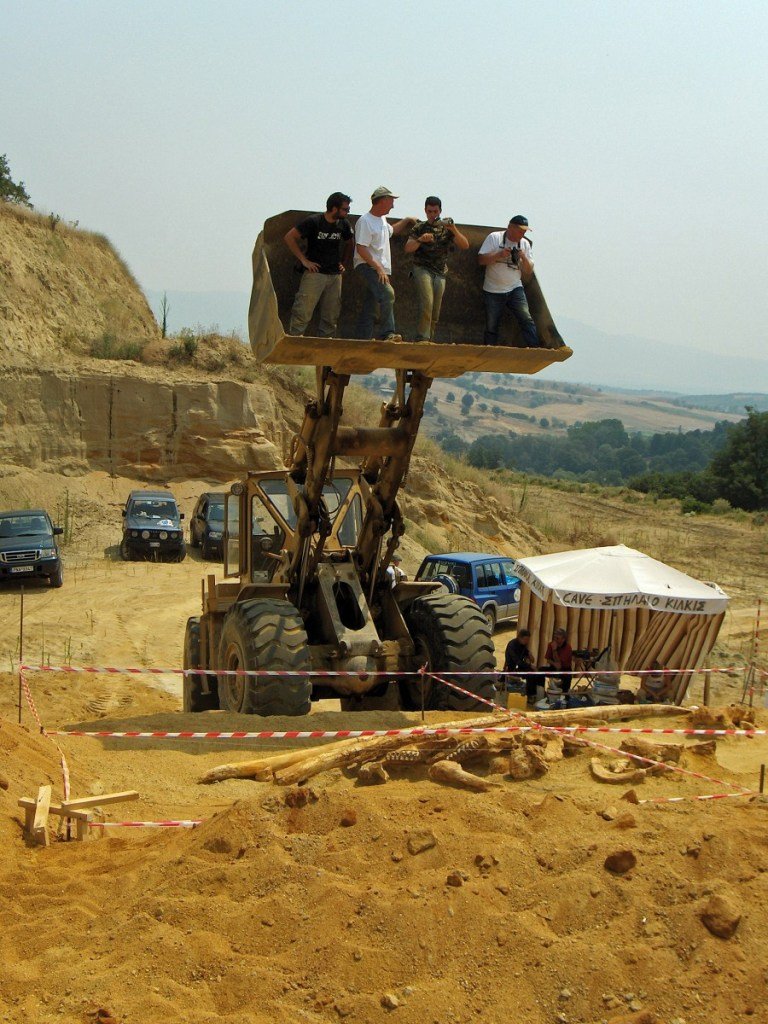
That day, some digital pictures were released to the BBC and, one hour later, these appeared on the news website of the BBC. The Mastodon of Milia-5 was now world news. More requests followed for more pictures and information from all over the world, keeping the team busy. However, there was no time for too much diversion, as there was a deadline to meet – Evangelia Tsoukala had an appointment with the local authorities from the Prefecture of Grevena on Saturday, 28 July. They were going to examine the results of the excavation team and the tusks had to be properly conserved and on display by then in the small palaeontological exhibition centre of Milia.

All remains unearthed had to be measured and drawn, which is a meticulous job. No data should be lost. Next, all skeleton parts (some 30 in total) had to be plastered for protection, preventing further damage during transport to the museum. These fossils had been subject to high pressure due to the weight of the almost 20m of overlying sand layers, and this caused deformation in many cases.
Accordingly, the tusks were shattered into several pieces and their enormous length prevented the crew from picking these up and transporting them all in one piece. These activities also had to be done in scorching hot weather and work went on until 22:30. Only drinking many litres of cold water kept the crew going.

But a deal is a deal, and on Saturday afternoon, 17:00 sharp, both tusks (a matching left and right pair) were put into position in the magnificent little museum in Milia. Their sizes, measured along the outside of the curvature (that is, the underneath surface) are 4.58m and 5.02m respectively. Therefore, these are the longest tusks in the world – another new world record.
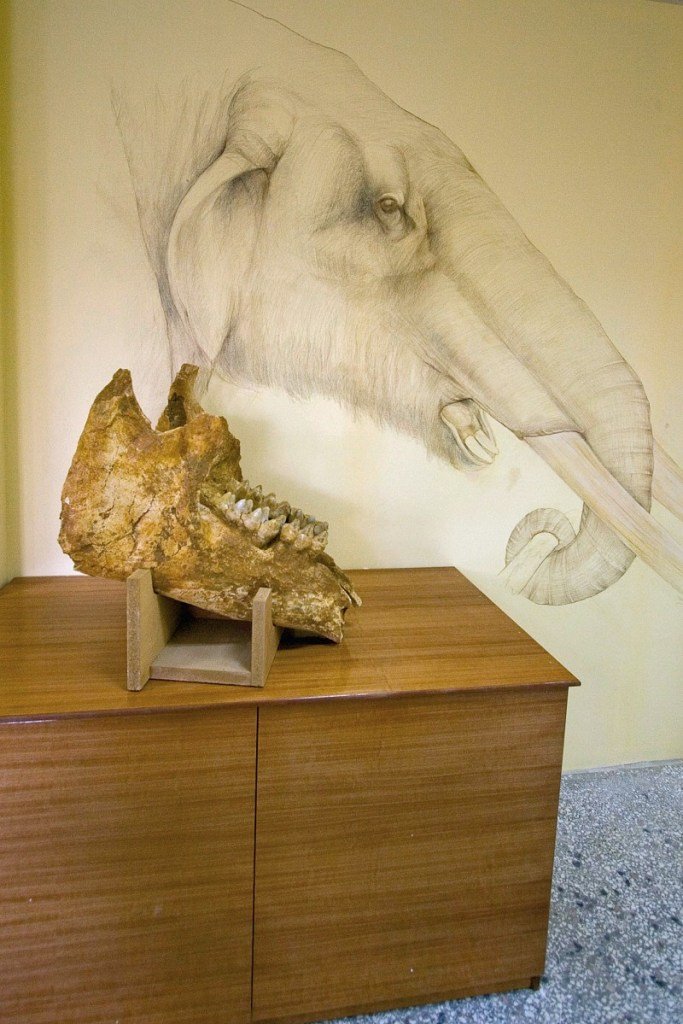
One wonders how an animal could live with those tusks. How could they have manoeuvred with them? The sheer inertia of their mass would cause significant complications making turns, not to mention avoiding obstacles, like rocks and trees. However, unlike elephants, the tusks do not point downwards but more forwards and one third of the tusk is also embedded in the dental socket. Moreover, the animal was a large bull in its prime, standing an estimated 3.30m to 3.50m at the shoulders.

So, this is how the palaeontological exhibition centre of Milia acquired an unique specimen, which attracts visitors from afar. However, they come not only to see the Borson’s mastodon, but also the other fossil mammal remains, collected in recent years, and nicely on display in the museum. Some are contemporary to the mastodon – antelopes, rhinos and a sabre-toothed cat, also excavated by Professor Tsoukala’s team. There are also remains of a second mastodon species, Anancus arvernensis, the mastodon of the Auvergne (see box).

| The mastodon of the Auvergne – Anancus arvernensis |
|---|
| The mastodon van Auvergne – Anancus arvernensis (Croizet & Jobert, 1828) – is a so-called bunodont mastodon, having molars with blunt dental knobs that are paired, lined up next to each other, forming transverse ridges. These molars suggest that the mastodon had a diet of softer food, like leaves, fruit and small twigs. The worn-down knobs of the upper jaw molars form a clover leaf pattern in profile, which makes them easy to distinguish from the lower molars. The relatively small and hardly-bent tusks are also characteristic for this species (Anancus = without a curve). Moreover, the lower jaw tusks are not present in many specimens, while the upper jaw tusks are covered with a thin layer of enamel. As indicated, these are near straight, bent only slightly outwards. The average shoulder height of this species is not more than 2.5m and, like in other proboscideans, there is a rather large gender dimorphism. Bulls are much larger, including their tusks. The much smaller cows also have tusks, but nowhere near as big. The Mastodon of the Auvergne used to inhabit Africa, Europe and Asia, but it got its name from a first description of a specimen from the Auvergne. (The name, Auvergne, is from the name of an old Celtic tribe meaning “those who are superior”.) This species became extinct at the beginning of the early Pleistocene, apparently coinciding with the emergence and fast dispersion of the southern mammoth (Mammuthus meridionalis) in Europe. |
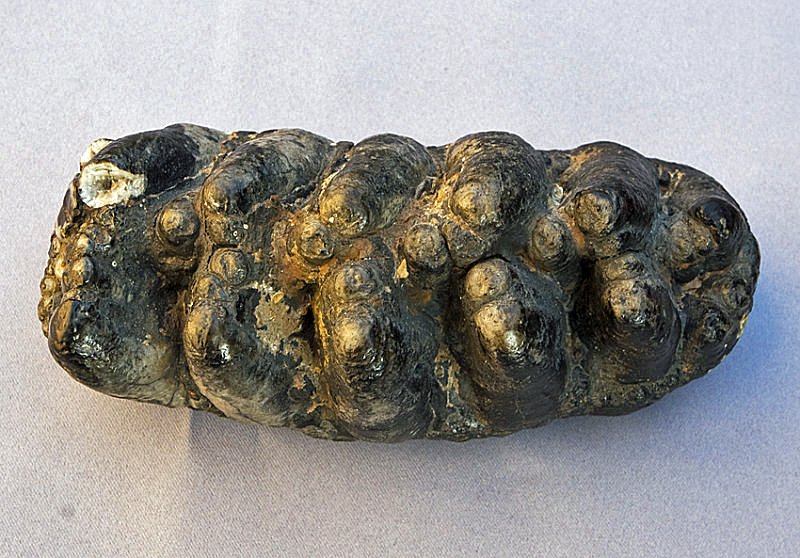
Clearly, the sandpit of Milia and the neighbouring areas are rich sources of remains of late Pliocene mammal fossils. This relatively little known fauna disappeared at the beginning of the Quaternary. It’s a diverse collection of animals, perhaps with many yet unknown species, including these two proboscideans, who may have shared the same biotope. This opportunity has led to creation of the Milia research project, focussing on the mastodons and associated fauna and their habitat. The students of Evangelia Tsoukala can’t wait to start. Several valuable projects are possible, including:
- Investigating the distribution of Mammut borsoni in Europe and Asia and the anatomy of the skeleton of Mammut borsoni.
- Creating a complete inventory of the Borson’s mastodon remains and of the Anancus arvernensis remains of Milia (1-5).
- Answering the question “Did Mammut borsoni and Anancus arvernensis co-occur”?
- Compiling a bibliography of Mammut borsoni.
The discovery of the longest tusks in the world has had a significant impact on the palaeontological centre at Milia. This has resulted, not only in more visitors, but also an increased supply of fossil remains, from a source that readers might not expect – local shepherds. They are the best eyes and ears of the palaeontologists in the area around the village.

As the sheep roam the hills, they trample the soil with their slender feet, sometimes uncovering fossil remains. And several local shepherds have found some very interesting fossils. Now, they are prompted to bring them to the museum, together with information about the location and conditions where they were found. Whenever professor Tsoukala is in Milia, she explores the area, like during the summer of 2008. A shepherd reported the finding of bones on a certain slope. Closer investigation revealed that it was the skull of an extinct rhino species, discovered by the trampling of sheep and a small team of students and experts went to the area. Some haste was required since sheep tend to walk the same paths again and again and might have damaged or even shattered the skull.

The expedition returned in the evening and, in the back of the car, was a delicate, almost complete skull of a Pliocene rhino. The finding place was documented with GPS so that it could be relocated for subsequent exploration. After all, it could be that a complete rhino skeleton was hidden in the soil there. Time will tell.
Obviously, the regional administrations also recognise the importance of the palaeontological centre and the activities of professor Tsoukala. They support her efforts and significant plans have been made for an intensive palaeontological research centre and museum – a mastodon museum. However, before that is realised, we have restyled the palaeontological centre of Milia (the Milia Museum of Palaeontology), with the help of skilful artists like Remie Bakker from Rotterdam in the Netherlands.
He is renowned for his accurate models of extinct ice age mammals like the Yukagir mammoth, which was in the Expo 2005 in Japan. He also made a brilliant scale model of our Borson’s mastodon based on the records and data collected by the Milia-5 team. There are also advanced plans to build a life-sized replica of this spectacular animal. Obviously, these costly enterprises need funding, which slows down the speed of realisation.
Nevertheless, the redecoration of the palaeontological centre has been successful. The Greek artist, Dimitra Labretsa, made a beautiful life-sized mural of the head of the Mammut borsoni of Milia, behind the original lower jaw of the mastodon unearthed in 2007 together with a model of the excavation. These belong to the highlights of the museum right now.
Further reading
Hays, J. 1834. Descriptions of the specimens of inferior maxillary bones of Mastodons in the Cabinet of the American Philosophical Society, with remarks on the genus Tetracaulodon (Godman), etc. Transactions of the American Philosophical Society, N.S., IV, 317-339. Washington.
Borson, E., 1830. Catalogue raisonné de la collection minéralogique du Musée d’Histoire Naturelle par L’Abbé Etienne Borson. Torino.
Trending Products










